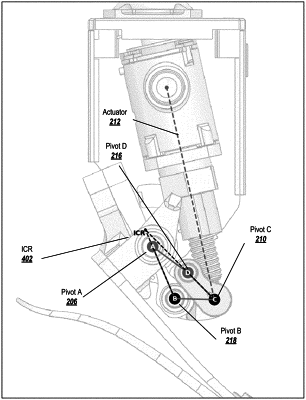| CPC A61F 2/68 (2013.01) [A61F 2/6607 (2013.01); A61H 3/00 (2013.01); A61F 2002/5007 (2013.01); A61F 2/644 (2013.01); A61F 2002/6614 (2013.01); A61F 2/70 (2013.01); A61F 2/74 (2021.08)] | 19 Claims |

|
1. A human augmentation device comprising:
a proximal member and a distal member directly connected by a single rotational axis corresponding to a human joint;
a linkage which transmits force between the proximal and distal members comprising at least four pivot axes and four links respectively connecting the pivot axes (A, B, C, and D), wherein a first link (AB) corresponds to the distal member, a second link (AD) corresponds to the proximal member, third (CD) and fourth (BC) links connect to the first and second links, and the pivot axis (A) connecting the first link and second link is the single rotational axis corresponding to the human joint; and
an actuator, wherein the linkage and actuator produce a mechanical advantage for the actuator to rotate the distal member relative to the proximal member and the mechanical advantage varies throughout a movement cycle of the linkage as a function of an angle between the proximal and distal members;
a predefined high-torque range is defined for a portion of the movement cycle during which the actuator imparts a relatively high torque between the proximal and distal members as compared to other portions of the movement cycle; and
an instantaneous center of rotation (ICR) is defined as a point where lines extending from the first and third links intersect, and the links of the linkage are sized and configured relative to each other to position the ICR relatively farther from a selected pivot of the fourth link as compared to a second pivot of the fourth link when the human augmentation device is in the predefined high-torque range as compared to the other portions of the movement cycle to increase the varying mechanical advantage in the high-torque range.
|